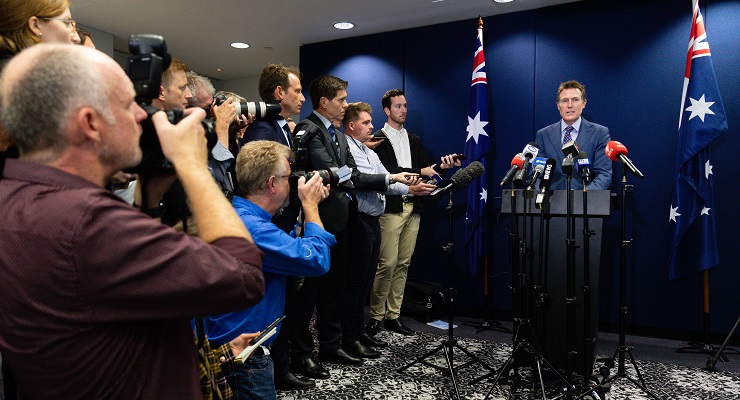
Every female journalist I know has stories about feeling like an outsider in their industry. Media isn’t even particularly male-dominated — women make up about 45% of the publishing workforce.
But it’s not just who is on the floor that represents equality. It’s who is taken out for dinner and coffee, who is put forward for training, or moulded for promotions. It’s who ends up with a door on their office versus who keeps working shifts on the newsroom floor. It’s who takes home the higher pay packet.
I’ve only been in the industry for about five years, so I wouldn’t have experienced what my more seasoned colleagues have. But even in those five years, I’ve noticed the difference in the way men and women are treated at news outlets.
At one publication where I was doing rotations across the sections my male colleague — same age, similar experience — was given stories on business and put forward for a role as a business reporter. Me? I was asked if I liked the royals.
“Not particularly,” I said, before adding I have a masters in international relations and pitching a manageable foreign affairs story.
“Well, I’m sure you’ll love it over there,” the editor said, shuffling me to the all-female lifestyle and entertainment section. The desk was littered with free make-up samples and had a bright purple backdrop. My first story for them likened Princess Diana to Cinderella. While the team was lovely, it wasn’t quite like the stories my colleague was breaking.
At another section of that news organisation, most of those working on the floor were women. The only people who had offices with doors were men.
There were sections of that organisation that were women-led (and covered things other than lifestyle) where female bosses helped me immensely. There were women pushing other women for top spots and supporting one another. But the disparity was still palpable.
The gender pay gap in information media and telecommunications sits at 16.6%, although according to a new report by the Women’s Leadership Institute Australia, this figure is likely to be understated, thanks to freelancers skewing the data.
At Crikey, things are better — but not perfect. I’ve been spoken over in meetings, endured references to “the boys”, and been asked to do admin-like tasks while my male colleagues continue working. While I’ve had scores of women reach out to me about several of my pieces, including comedy ones, our male-centric readership means this isn’t represented in our traffic, with some of my niche topics sliding down the rankings.
My coverage too is pretty gendered: 53% of health articles are written by women, which I cover. I’m also one of the few journalists who writes human interest stories (although these are often the pieces I am most proud of). Like this story, I write on sexual harassment and gender disparity, parenthood and women’s funding. If I don’t cover these topics, it’s unlikely many would make it into the edition (save for the brilliant Michael Bradley, who can speak on sexual assault law better than I).
But I also write opinion pieces (again, usually about gender). This is somewhat unique: men account for 65% of all opinion pieces published. I’d rather myself, with my “unique” lived experience of walking around this planet as a cis-gendered woman, cover these topics than have a male journalist step in and give his two cents on something he thinks he understands but doesn’t. This happens a lot at other organisations, and Crikey is no exception.
Media has come a long way, but it hasn’t come far enough. Crikey has come a long way too, from its beginnings as a male-dominated blog to what it is today. But again, we haven’t come far enough.








For god’s sake, ‘hang in there, Amber’. I think that you have written some terrific stuff. I cannot even remember if I have agreed with everything you have said or not – not that that matters one iota!
As far as journalists per se, go, I think that one of the best and most interesting and insightful is Niki Savva. Whenever I read her material or listen to her speaking I certainly sit-up and take notice.
Keep at it Amber whatever you do (especially if you enjoy the profession) and I also really appreciate your honesty and candor with respect to Crikey.
Forget the hair splitting the brutal facts are women arent getting an equal deal. End of story. Keep up the good work Amber.
I don’t doubt the rest, but this seems an odd complaint “My coverage too is pretty gendered: 53% of health articles are written by women, which I cover.”
The Australian population is currently 50.2% female. The disparity between that and the number of health articles written by women does not seem all that great. Or is Schultz complaining that 100% of the articles she writes are written by a woman?
77.9% of the health care and social assistance industries workforce in Australia are female, yet females are writing only little more than half of the coverage. That means almost half of the coverage is coming from a gender with no experience and little clue. I call that quite a large disparity.
This just adds to the confusion. On the one hand, the complaint is that not enough women are writing about certain topics. On the other hand, the complaint is that too many women are writing about certain other topics. Is this correct?
Also, if Schutz’s reason for specifically citing health articles as an example is based on the excess of women employed in the health care and social assistance industries above their presence in the general population, it would have been helpful to mention it along with the statistic you have provided; and it is far from obvious that “health” in her article means “health care and social assistance industries”. It could actually mean “health”.
I think the complaint is not enough women get to write the meaty articles.
As opposed to the vegetarian articles, no doubt. I expect you’re right.
Exactly!
Brilliant.